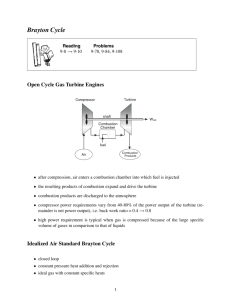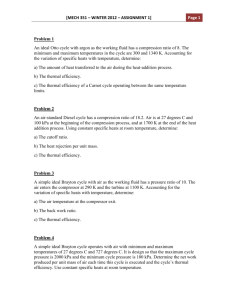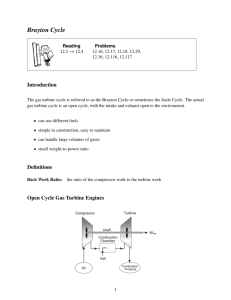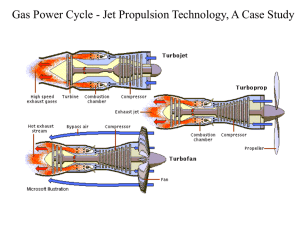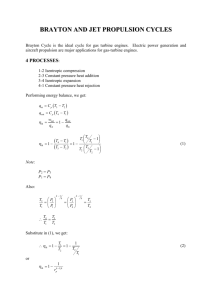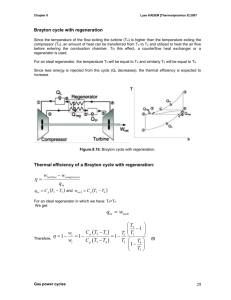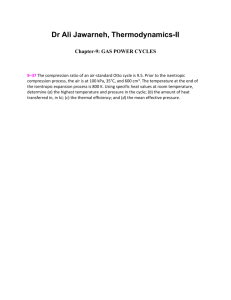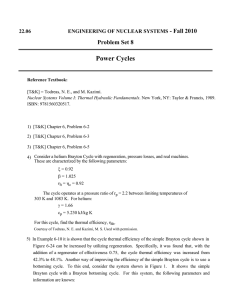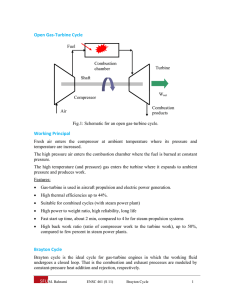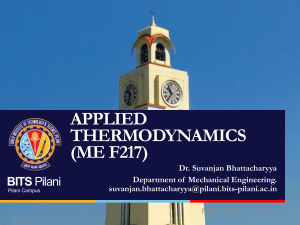EET_Gas Turbine Power Plant
advertisement
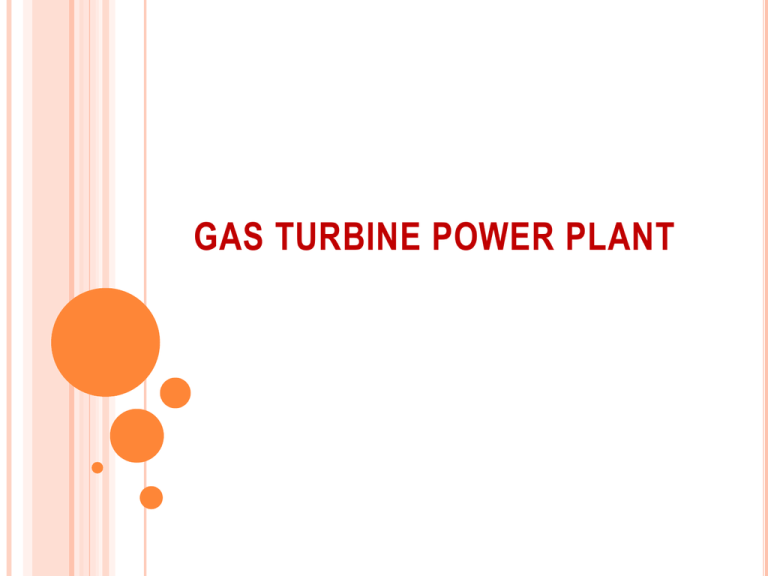
GAS TURBINE POWER PLANT Brayton Cycle: Ideal Cycle for Gas-Turbine Engines Gas turbines usually operate on an open cycle (Fig. 9–29). Air at ambient conditions is drawn into the compressor, where its temperature and pressure are raised. The high pressure air proceeds into the combustion chamber, where the fuel is burned at constant pressure. The high-temperature gases then enter the turbine where they expand to atmospheric pressure while producing power output. Some of the output power is used to drive the compressor. The exhaust gases leaving the turbine are thrown out (not recirculated), causing the cycle to be classified as an open cycle. Closed Cycle Model The open gas-turbine cycle can be modelled as a closed cycle (Fig. 9– 30). The compression and expansion processes remain the same, but the combustion process is replaced by a constant-pressure heat addition process from an external source. The exhaust process is replaced by a constant-pressure heat rejection process to the ambient air. The Brayton Cycle The ideal cycle that the working fluid undergoes in the closed loop is the Brayton cycle. It is made up of four internally reversible processes: 1-2 Isentropic compression; 2-3 Constant-pressure heat addition; 3-4 Isentropic expansion; 4-1 Constant-pressure heat rejection. The T-s and P-v diagrams of an ideal Brayton cycle are shown in Fig. 9–31. Note: All four processes of the Brayton cycle are executed in steady-flow devices thus, they should be analyzed as steady-flow processes. Thermal Efficiency The energy balance for a steady-flow process can be expressed, on a unit–mass basis, as The heat transfers to and from the working fluid are: The thermal efficiency of the ideal Brayton cycle, Constant specific heats where is the pressure ratio. Parameters Affecting Thermal Efficiency The thermal efficiency of an ideal Brayton cycle depends on the pressure ratio, rp of the gas turbine and the specific heat ratio, k of the working fluid. The thermal efficiency increases with both of these parameters, which is also the case for actual gas turbines. A plot of thermal efficiency versus the pressure ratio is shown in Fig. 9–32, for the case of k =1.4. Improvements of Gas Turbine’s Performance The early gas turbines (1940s to 1959s) found only limited use despite their versatility and their ability to burn a variety of fuels, because its thermal efficiency was only about 17%. Efforts to improve the cycle efficiency are concentrated in three areas: 1. Increasing the turbine inlet (or firing) temperatures. The turbine inlet temperatures have increased steadily from about 540°C (1000°F) in the 1940s to 1425°C (2600°F) and even higher today. 2. Increasing the efficiencies of turbo-machinery components (turbines, compressors). The advent of computers and advanced techniques for computer-aided design made it possible to design these components aerodynamically with minimal losses. 3. Adding modifications to the basic cycle (intercooling, regeneration or recuperation, and reheating). The simple-cycle efficiencies of early gas turbines were practically doubled by incorporating intercooling, regeneration (or recuperation), and reheating. Actual Gas-Turbine Cycles Some pressure drop occurs during the heat-addition and heat rejection processes. The actual work input to the compressor is more, and the actual work output from the turbine is less, because of irreversibilities. Deviation of actual compressor and turbine behavior from the idealized isentropic behavior can be accounted for by utilizing isentropic efficiencies of the turbine and compressor. Turbine: Compressor: Brayton Cycle With Regeneration Temperature of the exhaust gas leaving the turbine is higher than the temperature of the air leaving the compressor. The air leaving the compressor can be heated by the hot exhaust gases in a counter-flow heat exchanger (a regenerator or recuperator) – a process called regeneration (Fig. 9-38 & Fig. 9-39). The thermal efficiency of the Brayton cycle increases due to regeneration since less fuel is used for the same work output. Note: The use of a regenerator is recommended only when the turbine exhaust temperature is higher than the compressor exit temperature. Effectiveness of the Regenerator Assuming the regenerator is well insulated and changes in kinetic and potential energies are negligible, the actual and maximum heat transfers from the exhaust gases to the air can be expressed as Effectiveness of the regenerator, Effectiveness under cold-air standard assumptions, Thermal efficiency under cold-air standard assumptions, Factors Affecting Thermal Efficiency Thermal efficiency of Brayton cycle with regeneration depends on: a) ratio of the minimum to maximum temperatures, and b) the pressure ratio. Regeneration is most effective at lower pressure ratios and small minimum-to-maximum temperature ratios. Brayton Cycle With Intercooling, Reheating, & Regeneration The net work output of a gas-turbine cycle can be increased by either: a) decreasing the compressor work, or b) increasing the turbine work, or c) both. The compressor work input can be decreased by carrying out the compression process in stages and cooling the gas in between (Fig. 9-42), using multistage compression with intercooling. The work output of a turbine can be increased by expanding the gas in stages and reheating it in between, utilizing a multistage expansion with reheating. Physical arrangement of an ideal two-stage gasturbine cycle with intercooling, reheating, and regeneration is shown in Fig. 9-43. Conditions for Best Performance The work input to a two-stage compressor is minimized when equal pressure ratios are maintained across each stage. This procedure also maximizes the turbine work output. Thus, for best performance we have, Intercooling and reheating always decreases thermal efficiency unless are accompanied by regeneration. Therefore, in gas turbine power plants, intercooling and reheating are always used in conjunction with regeneration.

